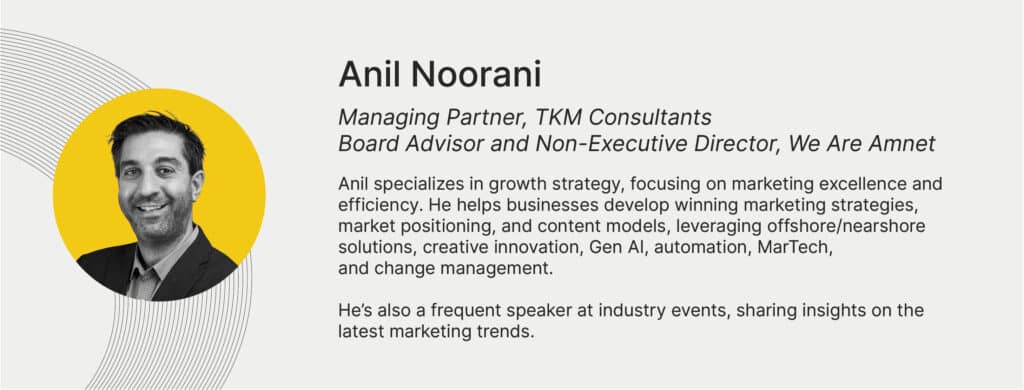The last few months have seen an unprecedented wave of mergers and acquisitions within the production and advertising sectors. Major players have come together in deals that span the entire spectrum of advertising, customer communications, and packaging. Among the most notable were Omnicom and IPG, RRD acquiring Williams Lea, and SGS acquiring SGK. These consolidations raise a crucial question: Why is this happening now and at such a rapid pace?
We talk to Anil Noorani, Partner, TKM Consultants and veteran in the advertising industry of 25+ years his thoughts on what it means for the wider industry and why now.
- Creative Production Technology Partnership of Brandtech Pencil Pro & Adobe Firefly.
- Matthews to sell SGK to a newly formed entity created by affiliates of SGS & Co
- Omnicom Group announced it would take over Interpublic Group (IPG),
- Publicis Groupe Forms Leo, Merging Leo Burnett and Publicis Worldwide Agencies
- RRD to Acquire Williams Lea

In the last 5 years there have been four major shifts in the industry, driven by technology and accelerated by the COVID-19 pandemic.
1. The Digital-First Strategy
The past decade has seen an undeniable move towards a digital-first strategy. Traditional marketing channels, such as TV commercials (TVCs) and print, have taken a backseat as digital content, social media, and digital out-of-home advertising have come to the forefront.
This shift has resulted in an explosion of content production, as brands need to cater to a vast array of digital and social channels. The rise of e-commerce has also played a major role, driving brands to create more online advertising content and pulling consumers away from traditional retail shopping.
The acceleration of this digital transformation due to COVID-19 was profound. Companies that were previously hesitant found themselves needing to rapidly adapt, leading to increased demand for digital marketing skills, performance marketing expertise, and new forms of content creation.
2. The Changing Consumer Landscape
Consumer behavior has evolved dramatically, particularly in the realm of personalization. Today’s consumers expect hyper-relevant, timely messaging that is tailored to their preferences and delivered across multiple devices at the right moment.
Social commerce has also surged, particularly among Gen Z consumers who seamlessly transition from content consumption to purchase within the same digital environment. User-generated content and influencer marketing have become essential components of brand strategy, as consumers themselves now play a major role in shaping the narrative of the brand.Moreover, the pace at which content is consumed has skyrocketed. Gone are the days when advertising was confined to scheduled TV ad breaks. Today, consumers are constantly exposed to branded content, creating an “always-on” economy that demands high-speed content production and delivery.
3. The Rise of In-House Agencies
Another major industry shift has been the substantial growth of in-house creative and production teams. The percentage of marketing spend allocated to production has increased from around 15-20% to between 30-35% in recent years. The In-House phenomenon was originally driven by the need for brands to manage production costs while maintaining the agility required to meet the demands of digital-first marketing.
According to the ANA, around 82% of their members now have some form of in-house agency, and this will peak at around 90%. While these teams were initially brought in for production, they are now moving up the value chain to work on creative strategy, planning, and ideation. As a result, lower-tier production work is increasingly being outsourced offshore, nearshore, or automated, allowing in-house teams to focus on higher-value creative work.
4. The Impact of Remote Work and Technology
The rise of remote working has led to the widespread adoption of digital workflow solutions such as Monday.com, Workfront and Asana. Virtually every in-house team now utilizes a workflow system or is actively considering one.
Additionally, the shift to remote work has accelerated the offshoring of production tasks, making nearshore and offshore solutions more viable than ever. At the same time, automation technologies have matured, particularly in the areas of digital, social, and video content creation.
Looking ahead, AI and machine learning will play an increasingly critical role in production and personalization. The challenge, however, lies not in the technology itself but in how quickly companies can adopt and integrate it into their workflows. Martec’s Law, coined by Scott Brinker, remains relevant today: technology evolves and changes at an exponential rate, while organizational adoption lags behind, at a logarithmic rate. Bridging this gap will require significant investment in upskilling teams and fostering a culture of technological engagement.
So onto the more recent changes within the marketing industry, we have seen many large mergers within the production and advertising sectors in the last couple of months.
Why do you think this is happening now, and how will these mergers solve the industry challenges?
As well as the reasons outlined above, over the past few years the economic climate and post pandemic recovery has driven the need for consolidation to tackle the challenges of:
- Building Greater Resilience: Companies are under increasing pressure to be more resilient. With tighter budgets, growing consumer demands, and an accelerated digital landscape, businesses are finding that merging can offer greater stability and efficiency than operating as independent entities.
- Cost Reduction: One of the most apparent benefits of a merger is the potential for cost savings. By consolidating operations, businesses can optimize shared services (such as HR, IT, and finance), and, in cases like Omnicom and IPG, leverage their scale to negotiate better deals on media buying.
- Expanding Client Base: Merging allows companies to extend their reach into existing and new sectors. For example, an agency with strength in financial services may merge with another that has a stronghold in an entirely different regulated industry like healthcare, thus broadening their market reach and opening up new revenue streams.We also often see one agency acquire another agency to strengthen their grip on a market. Omnicom and IPG have a significant market share in relation to healthcare agencies, and are the dominant players in this sector.
- Broadening Service: Businesses may be looking to diversify their services to remain competitive. Mergers provide an opportunity to integrate complementary capabilities, whether in creative content, data analytics, or performance marketing.
- Expanding Global Reach: For example, SGS are in 30 countries and SGK are in 24 so they potentially have extended global coverage now, improving their ability to cover a global marketplace.
- Acquiring New Technology: Innovation is a key driver. Acquiring a competitor with superior technology—whether in data analytics, generative AI, precision marketing, or automation—can provide a competitive edge. However, integrating these technologies can be complex and politically challenging.
Will These Mergers Succeed?
While the rationale behind these mergers is clear, their success is far from guaranteed. Several critical challenges must be navigated carefully:
- Cultural Integration: Merging companies often have different organizational structures and leadership styles. For example, Omnicom and IPG have historically operated with different levels of agency integration. Successfully blending these cultures will be a significant challenge.
- Technological Alignment: Omnicom’s Omni platform and IPG’s Axacom and Kineso serve similar functions in data analytics and performance marketing. Deciding how to integrate or prioritize these technologies will likely be a politically sensitive and complex process.
- Time and Execution: Mergers take time to fully integrate—often years rather than months. Achieving a shared vision, culture, and operational model will require patience, careful planning, and strategic leadership. In some cases, mergers fail to take hold, and companies end up parting ways.
- Client Uncertainty: Clients of merging companies may feel uneasy about potential disruptions to service quality, leadership changes, or shifting priorities. Competitors will see this uncertainty as an opportunity to poach clients, making customer retention a key challenge.
- Talent Retention: When former competitors merge, employees who have spent years competing against each other may struggle to collaborate effectively. As a result, there is likely to be significant talent attrition before the new organization finds stability. This loss of key personnel could negatively impact clients and overall business performance.
What do you think these mergers and acquisitions will mean for the advertising and production industry as a whole?
The recent wave of mergers in the advertising production industry may lead to fewer choices for brands, as larger consolidated companies gain more market influence.
However, the industry has evolved significantly in the past five years, with the rise of in-house teams, specialist agencies, offshore production, and automation reducing the dominance of traditional agency models. As a result, consolidation may have a smaller impact on pricing than in the past.
Many of these mergers seem to be driven by a need to maintain market position rather than expand it. While some clients may benefit from a “one-stop-shop” approach, others—who rely on hybrid or coalition models—may see little added value. Additionally, in the short term, large-scale mergers could prioritize efficiency over creativity and innovation, potentially opening opportunities for smaller, more agile players.
Ultimately, the success of these mergers will depend on how well these newly formed entities can adapt to an industry that is evolving faster than ever. If they focus too heavily on cost-cutting at the expense of creativity and agility, they risk losing ground to more specialised, innovative players. The future of advertising production will belong to those who can balance scale with innovation, creativity, efficiency, and adaptability.
Over the coming months and years, we will see whether these mergers deliver on their promises or whether they face the same fate as many ambitious consolidations before them. For now, the industry watches and waits.






